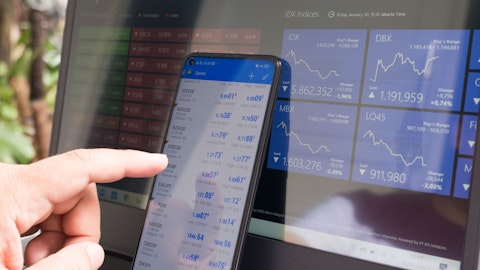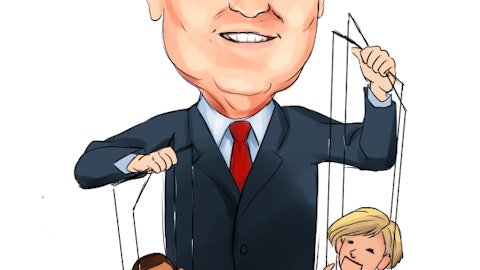Ravi Inukonda : Hey, Deepak, it’s Ravi. I’ll extend Tony start on the first question, and then I’ll take the second question, right? Like we — to your point around margins across the investment areas. What we’re seeing in the business is really strong performance, not just across growth, but when I look at the unit economics, there’s been a material step function change improvement, both on the new vertical side as well as the international side. And to your specific question on the contribution margin, if I look at the basket of our overall international business, there are several countries where the core restaurant business is actually contribution margin positive and still a lot of runway for both growth as well as improvement in the margin structure.
And your second point, Deepak, around Q4. Again, I mean the performance was great, right, like nothing specific that we would call out. What you’re seeing is volume continuing to grow. In fact, new verticals, the volume actually accelerated in Q4 compared to Q3. Grocery was a bright spot where grocery volume also accelerated in Q4 compared to Q3. International volume continues to be very strong, and we’re also seeing unit economic improvement. That’s basically what drove the performance both on the top line as well as the bottom line in Q4.
Deepak Mathivanan : Thanks so much.
Operator: Our next question comes from the line of Bernie McTernan with Needham & Company. Please go ahead.
Bernard McTernan : Great. Thanks for taking questions. Maybe just to start the New York City minimum wage. I saw you guys put through some price increases. Just wondering how you expect it to impact 1Q and the year. And then if our math is right, I think you guys added 5 million DashPass subs in ’22, 3 million in ’23, over the next year or two or maybe a couple of years, how big do you think DashPass can get — and any commentary on early benefits of Wolt+ if it’s been a contributor to the base?
Tony Xu : Sure. Bernie, it’s Tony. I’ll start and feel free to chime in, Ravi. First question is on regulation. I mean, by enlarge, the way we see the landscape is fairly similar to how we’ve seen it every year in the 10 years that we’ve been building DoorDash, which is most governments that we work with want to actually work with us and want to work with business. And they understand that in order for something like DoorDash to work, it has to work for all audiences. We’re always trying to keep the most affordable prices for consumers. We want to maximize the sales for local businesses, and we want to offer the most number of work opportunities for Dashers. The vast, vast, vast majority of places that we operate in work this way.
I think there are a handful of markets, one of which you called out, New York City, that kind of takes policies to the extreme. And I think has had some adverse impacts against its wishes, which is whenever you see regulation enter the way it does in a place like New York City, what you see is cost rise for the overall system. So there are — there’s less accessibility to consumers, to your point about rising costs. There are lower sales for local businesses, and there are fewer work opportunities for Dashers. And we largely expect that the vast, vast majority of cities will be fairly central in terms of how they think about working together with companies like ourselves. But there are a handful of markets in which have taken extreme policies.
We don’t expect that to change much in terms of the financial impact, all of that is reflected in our guidance. I think your second question was around DashPass. I mean, DashPass had a great year. I mean it was a record year in terms of its membership as well as the order frequency that we saw with DashPass subscribers. This includes Wolt+ as well. In fact, internationally, we actually saw the members for DashPass and Wolt+ double in the quarter. And so we’re certainly seeing quite a lot of strength there. I mean the way I think about it is, I mean, there’s 100 possible use cases per month for every consumer in terms of the categories and their consumption, whether that’s eating or buying in retail. Even for our best customers and certainly for the average subscriber, we’re just a fraction of those use cases.
So when I think about the runway, I think it’s quite far. And if we can certainly serve every use case for local commerce, I think the subscriber base would be fairly healthy.
Ravi Inukonda : Hey, Bernie, it’s Ravi. I’ll just add to Tony’s point around New York City. As you can see from the Q1 EBITDA guide, we are absorbing some of the regulatory costs in Q1. I do expect that to ramp down as we ramp up efficiency as well as we take other actions in the marketplace. And to your second point around impact on volume, again, it’s a small portion of the overall volume in the business. So I would expect the impact on volume to be very minimal.
Operator: Our next question comes from the line of Andrew Boone with JMP Securities. Please go ahead.
Andrew Boone : Thanks so much for taking my questions. I wanted to go back to the investments in international new verticals and better understand tactically what you guys are doing. Is the investments around improving selection? Is it on the consumer DASH or such? Just help us understand more directly what exactly it is that you’re doing? And then in the press release, you called out increased first-party distribution costs for COGS. Can you just talk about where you are with DashMarts and their progress towards profitability overall? Thanks so much.
Tony Xu : Hey, Andrew, I mean, I think you pretty much answered the question yourself, which is — I mean we’re investing in all the dimensions in which a consumer judges us, right? So we’re adding selection to the platform. We’ve launched a lot of awesome retailers over 2023. Even this year, we launched with Ahold most recently here in the U.S. We’re certainly helping to improve the affordability of the service, and there’s lots of work to do there. We are working on improving the quality of the service. I mean I think the hardest challenge that every grocer faces, whether it’s physically or digitally in terms of sales is knowing how much inventory they have on the shelves. And that is one of the biggest reasons in terms of why sometimes consumers prefer to go and shop inside stores.
And customer support is always something that we’re trying to get better. And when I look internationally, I mean, it’s similar, but it’s across more categories. It’s not just new verticals or retail, it’s also across the restaurant sector. We’re just a lot earlier there in terms of the penetration levels. We have a lot more places we have to launch. We have a lot more restaurants and retailers we have to sign up. We have a lot more work to do in terms of launching our subscription programs in the countries. I mean they’ve seen great adoption so far, but we’re very early in terms of the launch. And then we always have to make sure that we can make the product better.
Ravi Inukonda : Yeah, Andrew, I’ll take the second question around DashMart. I mean look, we’re really happy with where the footprint is. We’ve expanded the footprint a couple of years ago, just to make sure we have the volume density across all the markets that we operate in. Today, our focus continues to be driving same-store sales growth by better merchandising, continue to improve the overall product market fit. We have both retention as well as order frequency. When you look at the performance of the business, I mean, we’re really pleased. It’s doing well compared to plan. Our goal is to continue to improve, a, both the volume in that business as well as continuing to drive unit economic improvement where we’ve seen material improvement compared to last year. As I look at 2024, our priority is going to be continue to keep the existing footprint while increasing volume as well as driving unit economics in that business.
Andrew Boone : Thank you.
Operator: Our next question comes from the line of Brian Novak with Morgan Stanley. Please go ahead.
Brian Nowak : Hey, thanks for taking my question. I have two. The first one, Tony, on sort of prioritization of investments. I know you’re very data-driven. And so when you sort of look at the grocery and new verticals, you — you talked in the letter about adding more merchants, more seamless wording experiences, execution, pricing. When you sort of study the data, what is holding back adoption or driving churn or any of the negative you don’t want to see. Where are sort of the pinch points you really want to solve first to try to continue to drive some strong grocery adoption in 2024? And the second one, Ravi, to go back to one of your earlier answers, we talked about, you called a step change function on new vertical unit economics. Just any color on sort of which of the areas of the business in the blocking attack in sort of drove that step change improvement in unit economics in the year? Thanks.
Tony Xu : Hey, Brian, with respect to all of the barriers to adoption, I think there are a few, but I would start by saying that things in general are going pretty well. I mean we have over 20% of customers ordering in the non-restaurants category for the first time. I mean we’re now north of 100,000 plus stores that are outside of restaurants that are on our platform, which we estimate to be the largest in North America. More and more grocers, retailers are coming inbound, and then similarly, more and more consumers are shopping for the first time in the grocery category on DoorDash even ahead of restaurants. So I think there’s a lot of goodness to see. And if you think about what that’s centered on, that’s really been centered on the fact that we launched with this top of use case, which we effectively had to invent, if you think about it.
People knew DoorDash really as a place to get lunch and dinner very quickly. And so we launched this product where you can get your middle of the week run done as fast as possible. When you run out of eggs or cereal or your berries that usually isn’t like the most fulfilling trip to go inside a physical store yourself. But it’s also something you want to be done quickly. And so that’s something that we’ve solved pretty well. At the same time, I think there are a lot of barriers. I mean, if you just pan out and look at the industry, I mean, digital sales or e-commerce penetration of grocery is still amongst the lowest, if not the lowest across all categories of e-commerce. And I think there’s many reasons. First is how do you make sure that you can get exactly what a customer wants delivered to their home.
I mean if you look at one of the challenges that grocers have, whether it’s through their physical stores or their online channels, it’s not knowing how much inventory that they actually carry. There’s other barriers around affordability. I think customers largely expect to pay similar to what they pay inside the store when they get something delivered. And when you look at selection, that’s something that we’re just working towards. I mean it’s happening actually pretty rapidly and consistently where three years ago, when we just launched our service. We were working with maybe a couple of dozen of retailers now that’s in the hundreds with hundreds of thousands of stores. So that remains a thing. And I think the final thing is that it’s just going to take a bit of time.
I mean, I think most people in the country or in the world know DoorDash and Wolt has a place to get lunch or dinner delivered. I think it takes some time to get everyone to know that you can get your city delivered. We’ve certainly made a priority bet on grocery. I think it’s paid off really well. I mean we see it every day in the numbers in terms of growth, retention as well as improvements in unit economics. But look, it’s a long ways to go. I mean, we’re three years into it where we went from zero to multibillion, which we’re excited about, but I think it’s just the beginning.
Ravi Inukonda : Hey, Brian. On the second one, right, in terms of the step function change and improvement in unit economics, I’ll start off by saying, like in these businesses that we operate, one of the more important things is scale. Because ultimately, scale as we saw in the restaurant business, that drives volume growth, which ultimately drives efficiency in the business. If you combine that with the overall platform density that we have, whether it’s quality where we’re able to accrue benefits across the platform on improvements in credits and refunds or the dasher side efficiency. All of that is driving the improvements you’re seeing in the unit economic improvement across both restaurants and honestly, across all parts of the new verticals portfolio.




